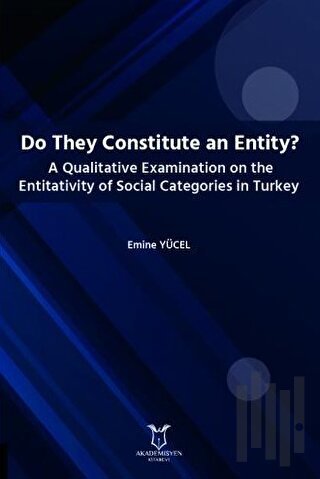
CHAPTER 1
INTRODUCTION
1.1. Defining Entitativity
1.1.1. Cues to Entitativity
1.1.2. Essence-Based vs. Agency-Based Entitativity
1.1.3. The Link Between Essentialism and Entitativity
1.2. Functions of Group Entitativity
1.3. Implications of Group Entitativity for Intergroup Relations
1.4. Critical Perspectives on Measuring Entitativity
1.5. Intergroup Relations in Turkey
1.5.1. Ethnic Divide: The Kurdish-Turkish Context
1.5.2. Religious Divide: The Alevi-Sunni Context
1.5.3. Ideological Divide: The AKP versus CHP Supporters
1.5.4. Gendered Divides: Working Women & Covered Women
1.5.4.1. Working Women
1.5.4.2. Covered Women
1.6. Current Research
CHAPTER 2
A QUALITATIVE EXAMINATION ON THE ENTITATIVITY OF SOCIAL CATEGORIES IN TURKEY
2.1. A Summary of the Study Objectives
2.2. Method
2.2.1. Participants
2.2.2. Qualitative Survey Questionnaire
2.2.3. Procedure
2.3. Results
2.3.1. What is the Lay Definition of Group?
2.3.2. What are the Salient Group Examples in People’s Minds?
2.3.3.1. Groupness Attribution
2.3.3.2. Basis of Rejecting the Groupness
2.3.3.3. Sociopolitical Determinants of Perceived Unity
2.3.3.4. Group-Related Determinants of Perceived Unity
2.4. Discussion
REFERENCES
CHAPTER 1
INTRODUCTION
1.1. Defining Entitativity
1.1.1. Cues to Entitativity
1.1.2. Essence-Based vs. Agency-Based Entitativity
1.1.3. The Link Between Essentialism and Entitativity
1.2. Functions of Group Entitativity
1.3. Implications of Group Entitativity for Intergroup Relations
1.4. Critical Perspectives on Measuring Entitativity
1.5. Intergroup Relations in Turkey
1.5.1. Ethnic Divide: The Kurdish-Turkish Context
1.5.2. Religious Divide: The Alevi-Sunni Context
1.5.3. Ideological Divide: The AKP versus CHP Supporters
1.5.4. Gendered Divides: Working Women & Covered Women
1.5.4.1. Working Women
1.5.4.2. Covered Women
1.6. Current Research
CHAPTER 2
A QUALITATIVE EXAMINATION ON THE ENTITATIVITY OF SOCIAL CATEGORIES IN TURKEY
2.1. A Summary of the Study Objectives
2.2. Method
2.2.1. Participants
2.2.2. Qualitative Survey Questionnaire
2.2.3. Procedure
2.3. Results
2.3.1. What is the Lay Definition of Group?
2.3.2. What are the Salient Group Examples in People’s Minds?
2.3.3.1. Groupness Attribution
2.3.3.2. Basis of Rejecting the Groupness
2.3.3.3. Sociopolitical Determinants of Perceived Unity
2.3.3.4. Group-Related Determinants of Perceived Unity
2.4. Discussion
REFERENCES
| Taksit Sayısı | Taksit tutarı | Genel Toplam |
|---|---|---|
| Tek Çekim | 135,30 | 135,30 |












